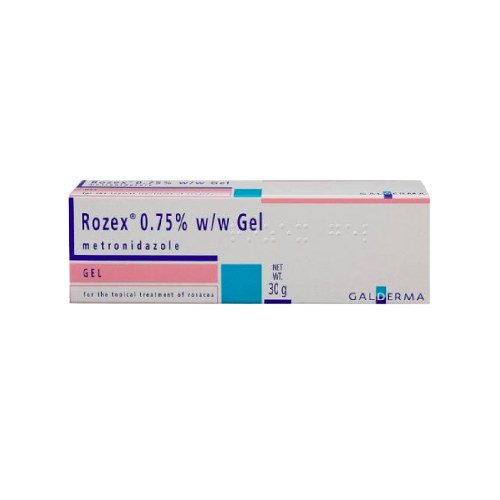- Effective treatment for Rosacea
- Antibiotic based cream
- Treats redness and pimples associated with Rosacea
- Genuine branded UK medication
Rozex
Rozex cream is a prescription-strength topical antibiotic medication.
It is commonly prescribed to treat a skin condition that causes blushing or flushing and visible blood vesicles in your face, called Rosacea. This is a skin condition similar to acne and prevalent among adults.
About Rozex
- What is Rozex?
- How long does Rozex take to work?
- How do you use Rozex?
- Can Rozex make your skin worse?
- Can Rozex cause dry skin?
- Does Rozex have any side effects?
- Rozex v Finacea v Soolantra
- Who can use Rozex?
- Can i use Rozex whilst pregnant?
- Rozex cream reviews
- Best product for rosacea
- Rozex and alcohol
- Documentation
What is Rozex?
Commonly used to treat the symptoms of rosacea, Rozex is available as a 0.75% cream.
Containing an antibiotic called Metronidazole, it is extremely effective and strong at treating a number of different infections in the body.
As a topical cream, metronidazole 0.75% is effective at treating skin infections, outbreaks and inflammation caused by rosacea.
Due to its strength and potency, it is only available when prescribed by a doctor or pharmacist to treat symptoms of rosacea.
How long does Rozex take to work?
The effects of Rozex on the skin can be seen from as early as a few weeks after starting treatment, but this can vary in each individual based on the severity of the rosacea infection.
Generally speaking, it can take a few months of continual use for the skin to become fully clear of spots, redness and inflammation.
It is important to continue with the full course of treatment, even if improvements in the skin are not seen straight away.
How do you use Rozex?
Always use Rozex as instructed by your doctor or dermatologist.
- First wash and dry the area of skin affected
- Apply a think layer of cream - being careful not to get it in to the eyes
- Rub cream well, into the skin
- Wash hands after use
- Use twice a day or as directed by your doctor
- Your doctor will decide how long you need to continue to use Rozex in order to keep the rosacea under control
- Avoid going out in direct sunlight, and apply SPF cream if doing so.
- Avoid using sun beds and UV lamps whilst undergoing treatment for rosacea
Can Rozex make your skin worse?
Generally Rozex is very effective at treating rosacea, and improvements in the skin are noticed as early as just a few weeks after starting the treatment.
A slight tingling or burning of the skin may be expected after this medicine is applied because of the strength of the active ingredient metronidazole.
This may feel irritating and might temporarily make your skin redder or more inflamed, however this usually only lasts for a short period of time.
However, if irritation continues or you feel like your rosacea is getting worse, it’s a good idea to speak to your doctor.
If you are sensitive or allergic to any of the ingredients in Rozex, the skin may become irritated and cause dryness, redness and itching.
If this occurs, speak with your own doctor or dermatologist who may advise you to use the gel less frequently, have a break for a few days, or stop using it altogether.
Can Rozex cause dry skin?
Rozex may cause dry skin in some people using Rozex, and it is listed as a common side effect (which means it can affect between 1 in 10 and 1 in 100 people).
Generally, these common side effects last for a short period of time (around a week or so) and tend to be mild. After this, skin dryness should go away.
Using a good, gentle moisturiser after applying Rozex gel can help with dry skin conditions.
Does Rozex have any side effects?
As with all medicines, Rozex may also cause side effects.
These side effects are most likely to occur at the start of treatment. Most side effects last for less than a week and are usually mild.
Common side effects of Rozex Gel include:
- Dry skin
- Redness of the skin (erythema)
- Itching of the skin (pruritus)
- Skin discomfort (burning, pain, stinging)
- Skin irritation
- Worsening of rosacea
As Rozex is applied topically (to the skin), and only a very small amount enters the bloodstream, therefore side effects tend to be localised at the site of application.
If you experience any side effects when using Rozex Gel and are concerned, you should speak to your doctor or pharmacist.
They may suggest decreasing the frequency of application, or if the side effects have not subsided, they may suggest trying an alternative treatment.
Rozex v Finacea v Soolantra
Rozex, Finacea and Soolantra can all be used to treat rosacea, but contain different active ingredients.
Finacea contains the active ingredient Azelaic Acid, and works by reducing keratin production on the skin cells. This can cause blocking of the pores and sebaceous glands on the face, which contributes to bumps and pustules forming on the surface of the skin. Finacea also has some antimicrobial properties, helping to reduce the production of a bacteria known as Propionibacterium acnes.
Soolantra contains Ivermectin, an antiparasitic agent that is commonly used to treat the symptoms associated with rosacea. It works by killing mites on the skin that release bacteria (which can cause rosacea).
Who can use Rozex?
Rozex can be taken by most adults with a few exceptions:
- Rozex gel is not recommended for children or anyone under the age of 18 because of its potency.
- Rozex may not be suitable for women who are pregnant or breastfeeding
- People who are on a blood-thinning medication (anticoagulants) such as warfarin should not use Rozex. This is because of the small chance it may interfere with this medication.
- Patients who suffer from blood disorders are also advised not to use Rozex.
- Rozex gel should not be used if you are allergic to metronidazole or any of the other listed ingredients (A Patient Information Leaflet can be found at the bottom of the page or inside the medicine box). If you have previously experienced an allergic reaction to a similar medication, you should also inform your doctor or pharmacist before starting a course of Rozex.
Can i use Rozex whilst pregnant?
Rozex is not suitable for use if you are pregnant or breastfeeding.
This is because metronidazole, the active ingredient in Rozex, enters the bloodstream in low amounts after being applied. Although these amounts are extremely low, it is currently unknown how this might affect the foetus during pregnancy or a baby during breastfeeding.
If you are pregnant or breastfeeding, think you may be pregnant or are planning to have a baby, you should ask your doctor or pharmacist for advice before taking this medicine.
Rozex cream reviews
Rozex is an efffective treatment for rosacea, and most people have start seeing the benefits of using Rozex from as early as 2-3 weeks after starting treatment.
Occasionally progress can be a little slower with the medication, but after a few weeks to months, the results are generally positive. Results are not always immediate, and the condition of the skin can get worse before it starts to get better.
This makes it even more important that people who begin using Rozex cream for rosacea should always complete the treatment as prescribed to get the best results.
Best product for rosacea
It is not a clear cut choice as to which treatment is the best for rosacea, and is based on individual circumstances and severity of the infection.
All the treatments have different modes of action, and come with their own side effects.
A qualified doctor, GP or dermatologist are best placed to make a clinical judgement as to which treatment is likely to work best for you.
Rozex and alcohol
Metronidazole taken orally can react with alcohol, however this reaction is unlikely when used topically on the skin.
It is still advised that you should avoid drinking alcohol whilst using Metronidazole.
Documentation
Patient Information Leaflet



We’re here to help.
Our friendly team is available to help Monday to Friday 9:00am - 5:00pm.
If you need urgent assistance, do not use this service. Call 111, or in an emergency call 999.

